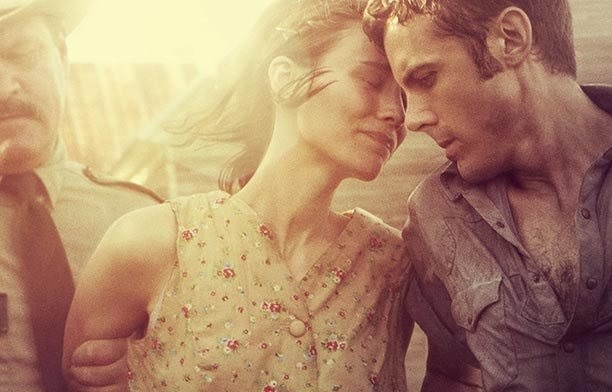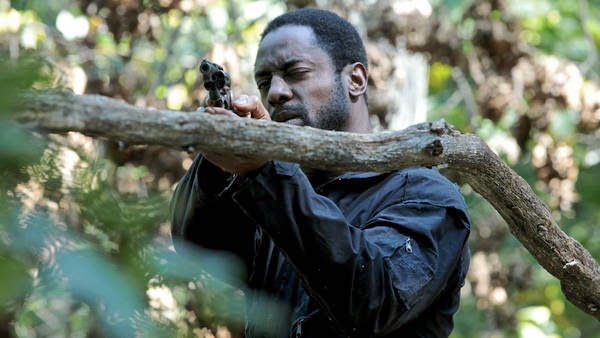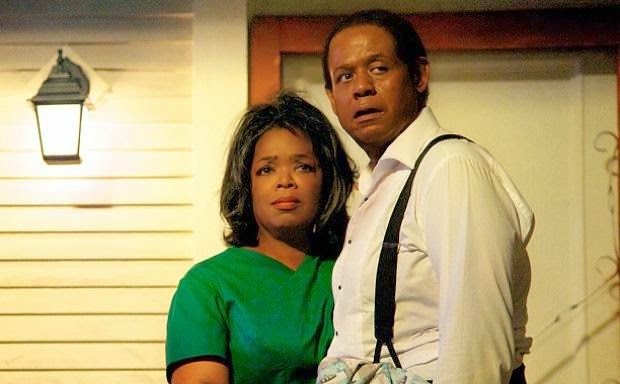Earlier in the Manifesto’s Review of 2013, we looked at the unmemorable movies of the year. Those movies were lackluster not because they were bad but because they barely tried to be good; they were inoffensive and harmless, meaning there was no reason to remember them. This post will highlight the flip side of the coin and examine movies that actually strove to be good but flopped in their attempt. In a way, these are nobler pictures in that they’re failures of misguided ambition and strenuous effort rather than of complacent mediocrity. But they’re failures all the same.
After Earth. People love to hate M. Night Shyamalan. That’s partly his fault, because he’s made some pretty bad movies, particularly the heartfelt-but-laughable Lady in the Water and the flat-out dreadful Last Airbender. But it’s also a testament to his distinctive personality as a filmmaker. Shyamalan has his flaws—he’s a terribly stiff writer, and his direction of actors is equally mannered—but he’s also a unique visualist with a gift for precise framing and strikingly off-kilter imagery, as he illustrated in Unbreakable and (especially) the unfairly maligned The Village. With After Earth, both his talents and his failings are on prominent, wince-inducing display. The movie is an impressive exercise in world-building, and the quest narrative affords Shyamalan the opportunity to create some fleet and exciting set pieces, most memorably when his poisoned and paralyzed hero must fall forward onto an upturned syringe in order to inject himself with antidote. Of course, the circumstances of that poisoning are murky and nonsensical, and therein lies After Earth‘s problem: It’s dumb. Shyamalan has always possessed too heavy a hand, and After Earth is a particularly lugubrious affair, with a childish story that alternates between ponderous and risible. That miasma of sufferance extends to the actors; the typically charismatic Will Smith seems to have been prohibited from expressing emotion, while his son, Jaden, simply can’t carry a big-budget action movie (possibly because Shyamalan seems incapable of coaxing a compelling performance from any thespian, much less a teenager). Still, ignoring the appalling special effects—which seem to have been lifted from one of those Cinemax soft-core flicks about hot scientists who capture Bigfoot—After Earth can be a treat for the eyes. But you may want to plug wax in your ears.
Ain’t Them Bodies Saints. On paper, David Lowery’s swooning homage to Terrence Malick reads like it can’t miss. Starring Casey Affleck (arresting as ever) and Rooney Mara (tender and tentative), the movie putatively relays the exploits of an escaped convict scrambling to return to his long-lost love, the woman who actually committed the crime that resulted in his imprisonment. But Lowery is less interested in telling a crime saga than in evoking a mood, one drenched in sweltering Texas heat and repressed longing. And so, Ain’t Them Bodies Saints shuns its potboiler elements, instead presenting us with scattered fragments: scenes that bleed into each other, shadowy antagonists whose presence is unexplained, a plot that meanders before ultimately disintegrating. It’s all sumptuous and dreamlike and frightfully dull. An intriguing sequence pops up here and there—it’s always refreshing when movie characters actually shoot and miss—but however painstakingly crafted those moments, Lowery obstinately refuses to stitch them together, and what remains is a limp phantasmagoria of irrelevant beauty. Ultimately, Ain’t Them Bodies Saints is personified in its depiction of a sympathetic sheriff, played by Ben Foster with uncommon decency and inhuman patience. He may be understanding and thoughtful, but he’s also deeply inauthentic, and after a time you wish he would drop the act and just fucking shoot someone already.
Anchorman 2: The Legend Continues. I don’t begrudge Adam McKay and Will Ferrell for making a sequel to Anchorman. They waited nine years, and as uneven as the final product feels, there’s at least the sense that it’s the product of genuine artistic affection rather than lazy commercial calculation. They made this movie because they wanted to, not because they had to. But that’s also somewhat troubling, because the first half hour of Anchorman 2 is possibly the most stifling 30 minutes I spent at the theatre all year. It’s certainly the least funny. The comedy, so fresh and unpredictable in the original, feels horribly strained; jokes that are lifeless to begin with become downright moribund, thrashing in death throes as they’re stretched far beyond their shelf life. Anchorman 2 is haplessly eager to please, but it falsely equates stupidity with hilarity, pummeling its audience with one moronic gag after another. Thankfully, things improve considerably once the movie acquires an actual plot—which also functions as a surprisingly sharp satire of modern network news—and the cameo-laden climax is suitably zany and chaotic, even as it blatantly copies its predecessor. Still, for someone who spent the past decade casually quoting the first film in everyday conversation, the sequel’s scattershot humor is dispiriting. Paramount recently released a new cut of the movie, purportedly featuring hundreds of new jokes while also adding 20 torturous-sounding minutes. That’s the studio’s prerogative, but the fact that McKay and Ferrell could so easily create a rejiggered version speaks to their fundamental sloppiness and indiscipline. Those qualities may sound brave and rebellious, but it’s the original Anchorman that proudly celebrates defiance. Anchorman 2 is just an indictment of incoherence.
August: Osage County. John Wells’ adaptation of Tracy Letts’ Pulitzer-winning play fancies itself an anthropological study of human misery. In the style of Eugene O’Neill, it cloisters a number of hot-tempered personalities under the same roof, then stands back and lets them eviscerate one another, hoping to illuminate social truths about the fragility of marriage and the recursive nature of familial strife. Insofar as evoking misery goes, the movie succeeds, because spending time with these people feels an awful lot like Hell. Yet there’s no truth to be gleaned here, no larger lessons to be learned. There is just the incessant slinging of cruel revelations (“You cheated on your wife!”) and foul insults (“Your son is dimwitted!”). To be sure, there’s nothing inherently wrong with movie characters behaving badly. The problem with August: Osage County is that the bad behavior feels mechanical, the product of a string-pulling writer (Letts penned the screenplay) who apparently believes that the surest route to pathos is the scrupulous accrual of nastiness. And so, there is much screaming, swearing, and crying throughout the film, but these boisterous displays of anger rarely resemble genuine emotion. We have no sense of these characters’ grander identities—they are simply mean to each other because the screenplay demands it. The cachet of Letts’ play allowed Wells to compile a remarkable cast, and the actors are game; in addition to Meryl Streep’s typical magnetism as a pill-popper, I most enjoyed Julianne Nicholson’s quiet yearning and Benedict Cumberbatch’s charming (and atypical) awkwardness. But after watching Streep’s umpteenth drug-fueled tirade, I became less transfixed than envious—she clearly had the good stuff, and I needed a valium.
Blue Caprice. I have no philosophical objection to filmmakers dramatizing tragedy (Munich was one of my favorite films of 2005), but if you’re going to dredge up past horrors, you’d better have a damn good reason. Alexandre Moors’ brooding reimagining of the Beltway sniper shootings—or, more accurately, of the twisted bond between the psychotic man and malleable boy who committed the killings—declines to depict the actual shootings that terrorized the D.C. community in 2002. This restraint is both a virtue and a limitation. In refusing to simulate the killers’ senseless violence, Blue Caprice avoids the taint of exploitation, and it shields Moors from reflexive accusations that he’s trading on real suffering for commercial gain. But the lack of visible chaos also saps the movie of urgency. Essentially, Moors hinges the film’s persuasiveness on the authenticity of the father-son bond that develops between the manipulative older man (Isaiah Washington) and the impressionable teenager (Tequan Richmond) who ultimately pulls the trigger. That bond, however, feels forced and artificial. We’re left to believe that the youth is spellbound by his benefactor’s erratic rants about ripping apart society’s fabric, but despite the electricity of Washington’s performance, the devotion rings hollow. Plot-wise, Blue Caprice lurches rather than glides, and that roughness drains it of its all-important credibility. A movie like this should terrify its viewers and force them to agonize over how such a calamity could have happened, yet this half-formed, grungy film induces frustration rather than fear. The chief horror of the sniper killings was that they seemed so random and pointless, but with its loose subplots and ineffectual character dynamics, Blue Caprice ends up feeling much the same.
The Heat. Pairing Sandra Bullock with Melissa McCarthy was an inspired idea. Bullock isn’t my favorite actress, but she’s an Oscar-winner, and she exudes a natural professionalism that contrasts beautifully with McCarthy’s anarchic disgust for convention. You’d think you could just put them on the screen and let them riff off of each other, then build an entire movie from the conflict and pandemonium that ensue. That’s apparently what director Paul Feig thought too, because The Heat is little more than a flimsy excuse for his two actresses to continually belittle one another. It’s fine for a movie to place its plot in the background (or, in this case, to essentially ignore plot altogether), but to do that the comedy needs to really zing. Yet while McCarthy again proves to be a spectacularly gifted mudslinger—she takes genuine glee in verbally assaulting others—the jokes in The Heat quickly grow stale. That’s partly because there’s really only one joke—Bullock is uptight and kowtows to authority, whereas McCarthy is crazy and wildly disrespectful—and the actresses can only mine so much comedic gold from such an exhausted vein. Feig, of course, directed Bridesmaids, but what made that movie work was that it actually committed to exploring its heroine’s gnawing anxiety, finding humor in her maniacal descent into despair. The Heat doesn’t commit to much of anything beyond the idea that McCarthy analogizing Bullock’s vagina to a musty old attic is funny. That sounds spry, but The Heat just wants to bludgeon you, and after listening to variations on the same joke for 90 minutes, your laughter will give way to groans of pain.
Lee Daniels’ The Butler. I’ll say this for Lee Daniels: He isn’t scared to try things, and he certainly doesn’t feel constrained by the standard notions of cinematic propriety. His prior feature, The Paperboy, was a feverish, batshit-crazy piece of swamp trash that infamously featured Nicole Kidman urinating on Zac Efron. The Butler isn’t as objectively lunatic, but it’s still a wildly ambitious overreach, a movie that seeks to compress the entire civil rights movement into a two-hour narrative about feuding fathers and sons. And for all of its many flaws, it’s undeniably entertaining, from the questionable stunt casting (is that Robin Williams as Dwight Eisenhower?) to the massive scope (it begins with a vicious murder in the 1920s and proceeds all the way to Obama’s ascendance) to the shrill, overheated arguments. And The Butler‘s goal—to distill the struggles of all of black culture into an intimate portrait of familial conflict and conciliation—is a worthy one. But it’s a losing proposition, and as Daniels name-checks every historical event surrounding the era—let’s see, here we have college students enduring abuse during sit-ins, and here’s Martin Luther King, Jr. delivering sage advice, and, wait, did someone just join the Black Panthers?—the movie begins to take the shape of the world’s liveliest Wikipedia page. Daniels has no problem aiming high, and here he’s shooting for that crown jewel of 1990s revisionist history, Forrest Gump. The problem is that, where Robert Zemeckis and Tom Hanks were in on the joke, The Butler plays things completely straight, and the result is an overstuffed sermon, one that sadly wastes fine work from Oprah Winfrey as the protagonist’s irascible wife (Forest Whitaker is less successful, burdened by the oppressive gravity of the title role). The movie pays proper reverence to the significance of its subject matter, but it fails to frame that subject with any degree of nuance. Still, it’s never dull, and in the end, The Butler is a bloated, messy testament to the theory that failures make better films than unmemorables do. This is two failures in a row from Daniels; I remain thoroughly intrigued by what he’ll bring us next.
More to come.
Previously in the Manifesto’s Review of 2013
The Unmemorables (Part II)
The Unmemorables (Part I)
The Worst Movies of 2013
Jeremy Beck is the editor-in-chief of MovieManifesto. He watches more movies and television than he probably should.







